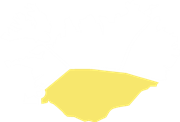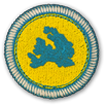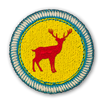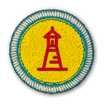Til hamingju is Icelandic for congratulations.
Now you have learned the A-Ö of Iceland and completed all of the regional classes. Hope you had some fun!



South Iceland is brimming with natural beauty, with new treasures unfolding at every turn. One of the most iconic is Jökulsárlón, a magnificent glacier lake known for its serene blue water bejeweled with floating icebergs.
The source of the icebergs is Vatnajökull, Iceland’s largest glacier, which looms over the lagoon just a little to the north. To the south is the coast, a vast stretch of black sand, where glassy icebergs rest before being swallowed by the sea.
The lagoon is not just water and ice, but also rich in sealife washed in by the tides. During winter, a sizable seal population gathers to feast at the mouth of the lake, and seabirds also hunt the area throughout the year.


Rivers snake their way all over the South. The longest, both in the region and in all of Iceland, is Þjórsá, which stretches 230 km from the central Highlands all the way down to the coast.
Ölfusá is far shorter at 25 km, but it is in fact Iceland’s most voluminous river. It is fed in part by Hvítá, which begins at a Langjökull and includes Iceland’s most famous waterfall, the enormous Gullfoss.
You may have noticed that these names all end in á, which, unsurprisingly, means river. It is pronounced “ow” (as in “cow”) and has almost as many other meanings as there are rivers in the South. In fact, it has so many homonyms that Á á á á, á á Á is a perfectly valid sentence in Icelandic.


One of the first things visitors notice when they come to Iceland is that there are almost no trees. Of the trees that do grow here, most are short, scrubby birch. As the perennial joke goes, “What do you do if you get lost in an Icelandic forest? Stand up!” While this stereotype isn’t too far from the truth, the South actually has several lovely forested areas, including Haukadalur, Þjórsárdalur, the Historical Pine Grove in Þingvellir, and the spectacular Þórsmörk nature reserve.
The most common tree species are birch and pine, and many forests have walking trails, recreational areas and campsites – perfect for a day of peaceful wandering. What many don’t realise is this hasn’t always been the case. As much as 40% of the country was forested until the time of the first settlers, who cleared the trees to create grazing land for their sheep.
Today, about 2% of the country is forested, though that is changing, with efforts to increase coverage to 12% by 2100.


Dyrhólaey is a spectacular promontory not far from the village of Vík. Its name means “door hole island”, and it is easy to see why as the 120-m cliff has large cut-outs at its base, forming a kind of natural bridge.
Just a few metres out to sea are some rather dramatic sea stacks. The cliffs are also a bird sanctuary and are therefore partially closed during spring to help protect nesting species, which include puffins and Arctic terns.
Dyrhólaey is just one of a long string of pearls that stretch from the inland and along the coast, and its nearby surroundings include other beautiful spots such as Reynisfjara beach, the Reynisdrangar sea stacks, and Mýrdalsjökull glacier to the north.


Back when Reykjavík was just a small village, Eyrarbakki was a bustling cultural and commercial centre, and even a candidate to become Iceland’s capital. Today its population is just 526, and it’s better known for its colourful preserved houses than sweeping skyscrapers.
The village also has two charming museums, the Eyrarbakki Maritime Museum and the Árnessýsla Heritage Museum – The House at Eyrarbakki. It’s wonderful to take a walk down to the shore, where the Atlantic Ocean crashes on the rocks. A little northwest of the village lies the Flói Bird reserve, a paradise for birdwatchers.


The South is home to most Iceland’s active volcanoes. The most famous is Eyjafjallajökull, which is part of the Katla UNESCO Global Geopark, a vast stretch of wilderness that covers over 9% of Iceland. The Geopark is named after Iceland’s most potent volcano, Katla and a bit further north is Hekla, which is likewise highly active.
There are also several volcanoes underneath the enormous Vatnajökull glacier, including Grímsvötn which erupted in spectacular fashion in 2011. And for an off-shore volcano experience, it is wonderful to take the ferry to Vestmannaeyjar, an archipelago off the south coast that was transformed by an eruption in 1973.


For action-seekers, the South offers a huge range of engine-based activities. ATV are a great way to explore the black sand beaches of the south coast; and up on the glaciers Mýrdalsjökull, Eyjafjallajökull and Vatnajökull, you can go zooming across the snow on snowmobile and super jeeps tours.
The adventure doesn’t end on land, as there are river jet tours on the Hvítá river rapids, and Ribsafari tours around Þorlákshöfn and Vestmannaeyjar. And for anyone interested in a bird’s eye view, there are also helicopter and light aircraft tours.


South Iceland is home to many of Iceland’s most impressive waterfalls. Gullfoss which is a part of the Golden Circle tour and the handsome Skógafoss, further south, are two of the most photographed waterfalls in Iceland.
About 30 km from Skógafoss is the elegant Seljalandsfoss, which you can actually walk behind – if you don’t mind getting a bit wet. Also hidden nearby is Gljúfrabúi waterfall, the “gorge dweller”, which is tucked behind a cliff just a little further north.
Perhaps the most unusual waterfall, however, is Svartifoss (“black waterfall”), which is set amidst dramatic columnar basalt in Vatnajökull National Park.


Geysir is probably the most famous geyser in the world, so much so that the word geyser actually derives from its name. In its prime, it would blast boiling hot water as high as 170 m into the sky, but in recent decades it has become mostly dormant, while its smaller sibling, Strokkur, has taken over.
Strokkur erupts every few minutes, reaching as much as 30 m in height. The surrounding geothermal area is also intriguing, with hot springs in shades of azure and turquoise, and hissing sulphurous steam vents all around.


Few dishes are more beloved in Iceland than langoustine, which locals often refer to as lobster, though it is actually about the size of a large prawn. What it lacks in length it more than makes up for in flavour, and it is simply heavenly with melted butter and garlic.
Much of Iceland’s langoustine is caught off the shores near the coastal towns of Þorlákshöfn and Höfn and a number of excellent restaurants in the region serve them fresh off the boat. The town of Höfn celebrates this bounty every summer with the annual Lobster Festival.


Iceland’s hot springs have a rather distinctive fragrance that has been compared to the smell of rotten eggs. This is from the sulphur, the yellow mineral that is often visible in geothermal areas. Some visitors will also notice a milder version of this aroma when they turn on the hot water in Iceland.
This is because virtually all of Iceland’s hot water comes from geothermal sources, allowing people to heat their homes with clean energy at very little cost. Thankfully, the water from the cold tap comes from a different source and is absolutely delicious, free from chlorine and among the purest in the world.


While South Iceland is wonderful in summer, the region saves some of its most exquisite delights for the long months of winter. By around November, melt water begins to refreeze, forming magnificent ice caves in glaciers such as Vatnajökull and Mýrdalsjökull.
The caves exist in a perpetual state of flux, melting and refreezing in different forms, colours and places. Due to this unpredictable nature, they can also be extremely dangerous, so even the most confident trekkers should stick with a qualified guide.


South Iceland is always on the move; growing, transforming, and sometimes shaking a little too. This is because it sits on top of two tectonic boundaries, where the Mid-Atlantic Ridge runs right through the centre of the country. Minor earthquakes are relatively common in these areas, though it’s rare to feel anything more than a small rumble.


The South’s dramatic landscapes have provided the backdrop for many a Hollywood movie. Vatnajökull glacier has starred in Interstellar, Batman Begins and The Secret Life of Walter Mitty, while Jökulsárlón, the spectacular lagoon at the glacier’s edge, has appeared in Lara Croft: Tomb Raider and two James Bond movies.
The coast further west has also been popular, making a cameo in films such as Thor 2: The Dark World and Noah, and scenes from Oblivion and Prometheus were shot in the Highlands further north.
Although not a movie, it is impossible to discuss filming in Iceland without also mentioning Game of Thrones, which has famously been shot in various locations around the South and beyond.


It's a well known secret that the sweet, chubby puffin is the nation’s true favourite creature. They are particularly plentiful along the south coast, and you can see large nesting colonies in the cliffs at Reynisfjall, Dyrhólaey and Ingólfshöfði.
The largest colony, however, is in the Vestmannaeyjar archipelago off the south coast. It’s well worth the trip, both to see the puffins and to explore the island itself.


The South produces many delicious ingredients, including lamb, seafood, and most of Iceland’s fresh fruit and vegetables, which are grown in geothermal greenhouses. It is also home to a number of wonderful restaurants, ranging from elegant fine dining to cosy cafés.
Seafood lovers should stop for some delicious fresh fish or lobster soup in coastal towns such as Eyrarbakki, Stokkseyri and Höfn, while lovers of lamb will find their fill at farmhouse restaurants a little further inland. Many places also have good options for vegans and vegetarians, particularly around the greenhouses.


The South region is an ideal place to just relax and enjoy. There are plenty of beautiful spots for a wander: between the birch trees, beside a waterfall, or along the black sands of the coast.
The region’s towns and villages are also a delight to explore, each with their own local character, and probably a museum and a café or two. And with so many natural pearls in close proximity, it’s easy to pack in a lot without ever feeling rushed.


The South is not only beautifully green, it is also rich in green energy. Iceland relies on water, wind and geothermal heat for its power, with over 70% of the nation’s energy consumption supplied by clean, renewable sources.
The largest geothermal power station in the country is Hellisheiðarvirkjun, located south of Þingvellir in the Hengill volcano, a geothermal plant that uses steam to generate electricity.


The Highlands are one of the last true wildernesses in Europe, extending 40,000 km2 over Iceland’s interior. The region is uninhabited and uninhabitable, a volcanic desert where nature is raw, unforgiving, and utterly spectacular.
Many of the most magnificent spots are in the South region, including the colourful rhyolite mountains of Landmannalaugar, the hot-headed Hekla volcano, the surreal Kerlingarfjöll mountains, and the moon-like Lakagígar craters.
It is important to note that the Highlands can be as merciless as they are beautiful, so anyone entering the area should come fully prepared and check conditions in advance.


For over 700 years, Skálholt was one of the most important places in Iceland, and it remains one of the most holy. Between 1056 and 1785 it was an episcopal see and a centre of learning, culture and politics. The current cathedral in Skálholt was consecrated in 1963 and is the 10th church to be built on that site.
The acoustics inside are wonderful, and during summer there is a popular festival that features a mix of contemporary and baroque compositions. Concerts and other events also take place throughout the year. Skálholt is considered a holy place and visitors are asked to respect the site.


South Iceland is the birthplace and setting of many of Iceland’s most important contributions to world literature. Perhaps the most famous example is Njáls saga, which was written in the 13th century by an unknown author and remains a riveting read even 800 years on.
It describes events that took place in the Rangárþing region between 960 and 1020, when a fierce blood feud broke out between Hallgerður and Bergþóra, the wives of friends Njáll Þorgeirsson and Gunnar Hámundarson.
South Iceland has numerous interesting historical sites and museums connected to Njáls saga and other Icelandic literature, both ancient and recent.


In most parts of the world, the word “beach” conjures up images of golden sands, surf and suntans. Not so in South Iceland. Here, the coast is raven-black and moody, with waves that are best left seen and not touched.
The most famous black beach is Reynisfjara, where you’ll also find the Reynisfjall cliffs with their columnar basalt base; and Reynisdrangar, distinctive basalt sea stacks that perforate the sky. According to local folklore, these rock formations are actually trolls who got turned to stone while trying to drag a ship into land.


The lowlands of South Iceland stretch almost 100 km from the Hellisheiði plateau to Eyjafjallajökull glacier. This flat and fertile land is ideal grazing country, and there are many sheep farms in the area.
Sheep are typically free to roam the countryside until autumn, when farmers head out on horseback for the annual round-up. Icelandic lamb is among the best in the world, with a sweet, delicate flavour that is enhanced by the sheep’s healthy diet of grass and wild herbs.


While polymer fleece has its uses, Iceland is a nation of knitters. The most popular yarn is lopi, made from the wool of the Icelandic sheep and commonly knit into patterned sweaters known as lopapeysur. Most of the country’s wool is produced by one large company, but there are also smaller local producers.


Camping is a wonderful way to experience South Iceland’s landscape, and it also doesn’t hurt that it’s the cheapest accommodation available. There are many campsites all over the region, typically open from the beginning of June till early September, though this can vary depending on local conditions, some are even open all year round.
Campers are strongly encouraged to stick to official campsites, both for their own safety and to protect Iceland’s delicate environment. If you wish to camp elsewhere, you will need get permission from the landowner first.


Following the recent influx of travellers, many farms in the South have diversified and now offer accommodation on their premises. Farm stays are particularly friendly and personal, and guests are generally welcome to come and see the day-to-day runnings of the farm.
Accommodation can range from cheap and cheerful to somewhat more luxurious dwellings, and many farms have hot tubs available for use by guests. Hosts can also offer excellent suggestions for things to do in the area, so be sure to stop for a chat.


Icelandic horses arrived with the first settlers and have been bred pure for over 1000 years. They are a compact breed, stocky and sturdy, and much tougher than their cute appearance suggests.
The South prides itself on its horses, and visitors to the region will see them wandering the lowlands by the dozens. Numerous riding tours run in the area, with options suitable for all levels of skill.


The South is Iceland’s largest region and is home to an incredible variety of landscapes and recreational activities. When planning your travels, it is well worth taking a look around www.south.is, which is packed with useful information about where to go and how to get there. The website also helps you find tours, restaurants and accommodation in the region.


Two of Iceland’s three national parks are in South Iceland. The largest by far is Vatnajökull National Park in the southeast, which is 14,141 km2, or about 14% of Iceland’s total area. It encompasses Vatnajökull glacier, Jökulsárlón glacier lagoon, the former Skaftafell National Park, as well as numerous other marvelous spots.
On the southwest side of the region is Þingvellir National Park, which is known both for its natural beauty and its historical importance. It was here that Iceland’s parliament, Alþingi, was established in the year 930, and today it remains world’s oldest functioning parliament.
Þingvellir is also famous for its geological features, which include deep rifts where the North American and Eurasian tectonic plates are diverging at a rate of about 2 cm per year.


Outdoor enthusiasts can choose their own adventure in South Iceland, which has a wealth of exciting activities on offer. One of the most popular is snorkeling or scuba diving in the Silfra fissure in Þingvellir, while the Davíðsgjá fissure nearby is more of a hidden gem.
If you’d prefer to stay above water, you can try kayaking along the coast, or even on the Heinaberg glacier lagoon. Other adventuresome types will appreciate paragliding, ziplining, spelunking, hiking, ice climbing, mountain biking, fat biking, horse riding, and more.


The South Region’s landscape is utterly magnificent, but also wild and raw. Most attractions do not come with guard rails, and signage is often minimal or non-existent. It is therefore essential to exercise common sense and heed warnings carefully, both for your own safety and to protect the delicate environment.
Preparation is also key. Make sure to pack clothes and supplies for all conditions, check the weather forecast before you set off, and let people know where you’re going. For detailed advice head to www.safetravel.is, and while you’re there be sure to download the 112 app, which allows you to check in and make emergency contact even without a phone signal.
Now it is time to learn more about the 7 regions of Iceland.
Take the quiz to test out your skills and be one step closer to know all about the 7 regions of Iceland!


You just aced this class so you are now one step closer to knowing the 7 regions of Iceland inside out.
Share on Facebook


Now you have learned the A-Ö of Iceland and completed all of the regional classes. Hope you had some fun!
Finish all the classes to have the chance to win a trip to Iceland


There is something magical about the Westfjords, the region that could arguably be labelled "Iceland's best kept secret". Isolation has preserved the region in a relatively unspoiled wilderness, making it a must-see for any serious explorers.


It's all about beautiful contrasts in the North, a land where long valleys and peninsulas are interspersed with big mountains, lava fields and smooth hills carved out by powerful rivers. Go big or go home!


If drifting through picturesque fjords from one warm town to the next is your cup of tea, head to the East. It is home to the country's largest forest, lush farmlands and even the mysterious lake monster in Lagarfljot.


What's so cool about Reykjanes? Not only is it where most visitors set foot in, a geothermal wonder and the home of the spectacular Blue Lagoon, but also a place where lighthouses outnumber villages.


If the regions were pop songs, the South would probably be the chart-topping hit, since it is renowned for its beauty and the home of some o f the country's most visited tourist attractions.





